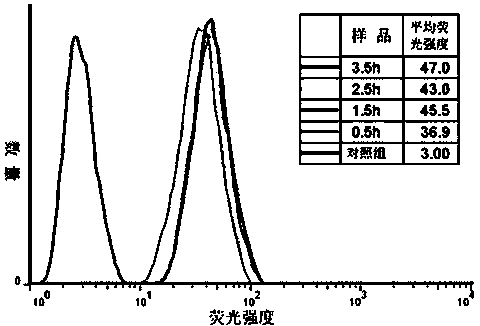Quinazoline fluorescent probe as well as preparation method and application thereof
A technology of fluorescent probes and quinazolines, which is applied in the field of quinazoline fluorescent probes and their preparation, can solve the problems of reduced drug efficacy, and achieve the effects of simple operation, fast analysis, and high inhibitory activity
- Summary
- Abstract
- Description
- Claims
- Application Information
AI Technical Summary
Problems solved by technology
Method used
Image
Examples
Embodiment 1
[0040] Preparation of fluorescent probes
[0041] (1) In a 100mL single-necked flask, 1.1g (about 6.59mmol) of ethyl bromoacetate, 2.0g (about 6.27mmol) of raw material a: (4-(3'-chloro-4'-fluorophenylamino)- 7-methoxy-6-hydroxyquinazoline), 2.6g (about 18.8mmol) of potassium carbonate were dispersed in 20mL of N,N-dimethylformamide solvent, stirred at 40°C, followed by TLC to observe the reaction process, the reaction is complete in about 0.5 hours, stop the reaction, filter the reaction solution, collect the filtrate, drop the filtrate into 80mL of distilled water, and immediately precipitate a large amount of yellow precipitate, after standing for 2 hours, filter, collect the filter cake, and vacuum dry to obtain The crude product was recrystallized with a mixed solvent of V (dichloromethane): V (methanol) = 20: 1 to obtain a light yellow precipitate pure product b, which is an acetate derivative intermediate, and the yield was 75%; Melting point, and carry out mass spectr...
Embodiment 2
[0048] Probe biological activity detection
[0049] (1) ELISA measures the IC of quinazoline fluorescent probes of the present invention inhibiting EGFR protein kinase activity 50
[0050] The kinase inhibitory activity of the synthesized compound d was determined by enzyme-linked immunosorbent assay (Enzyme Immunosorbent Assay, ELISA). Using the protein kinase detection kit of CST company: PTP1B (Tyr66) Biotinylated Peptide as the substrate of the kinase EGFR (Epidermal Growth Factor Receptor), the inhibition degree of compound d to the phosphorylation reaction of the kinase substrate was investigated by spectrophotometry, and determined IC 50 value.
[0051] In the ELISA experiment, positive control and negative control are used to control the experimental conditions. In order to improve the test accuracy, three groups of parallel experiments were performed for each concentration. A known EGFR inhibitor (4-(3'-chloro-4'-fluoroanilino)-7-methoxy-6-hydroxyquinazoline) was...
Embodiment 3
[0056] Determining the localization distribution of probes on the cell membrane
[0057] (1) Cell culture
[0058] Five cell lines (all purchased from the Cell Resource Center, Institute of Basic Medical Sciences, Chinese Academy of Medical Sciences): A431 epidermal squamous cell line, A549 human lung adenocarcinoma cell line, HeLa human cervical cancer cell line, MCF-7 human breast cancer cell line strain, HBE human bronchial epithelial cell line. Medium composition: DMEM with antibiotics (100U mL -1 Penicillin and 100mg mL -1 streptomycin) and 10% fetal bovine serum. Cell seeding density: 5×10 cells per 100 mm culture dish 6 , at 37°C with 5% CO 2 Culture in a cell culture incubator until the cells cover 80-90%, and replace the medium every two days or so.
[0059] (2) Fluorescence confocal imaging
[0060] Before the experiment, use 1×10 per dish 4 Cells were inoculated into confocal glass small dishes, each dish was added with 1.5mL medium, at 37°C with 5% CO 2 Cu...
PUM
 Login to View More
Login to View More Abstract
Description
Claims
Application Information
 Login to View More
Login to View More - R&D
- Intellectual Property
- Life Sciences
- Materials
- Tech Scout
- Unparalleled Data Quality
- Higher Quality Content
- 60% Fewer Hallucinations
Browse by: Latest US Patents, China's latest patents, Technical Efficacy Thesaurus, Application Domain, Technology Topic, Popular Technical Reports.
© 2025 PatSnap. All rights reserved.Legal|Privacy policy|Modern Slavery Act Transparency Statement|Sitemap|About US| Contact US: help@patsnap.com



